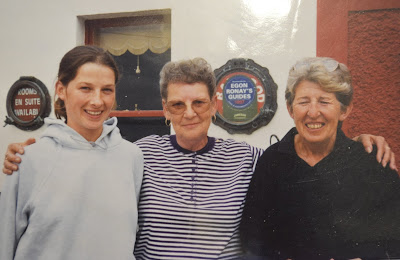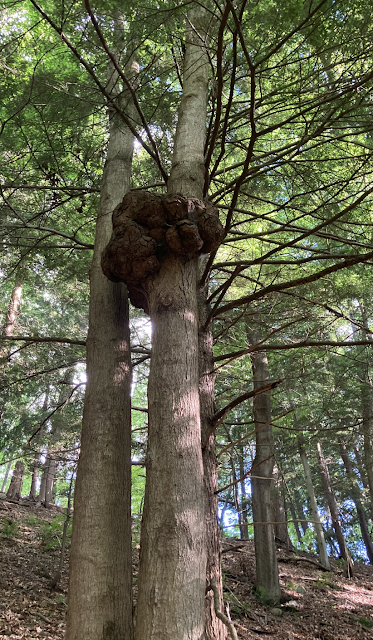A Forest Sounds Like a Ship at Sea:
Roots and Branches
Day 26: Remote Residency at Uillinn: West Cork Arts Centre, Skibbereen, Ireland, 7/18/22 to 8/13/22, Maria Driscoll McMahon checking in from New York State
Meanwhile, I could not have taken on a project of this magnitude without the help of many people.
First of all, my Aunt Sylvia Hilfiger née Driscoll, from whom I first learned of the ancestral village called "Baltimore." Without her explorations I would not have known a thing about our ancestry.
 |
| Aunt Sylvia (in center) in Baltimore a few decades ago |
.png) |
| Aunt Sylvia today who is still sharing stories, memories, clippings, photographs! |
Margaret Walsh, Dixie Gross, Christine Bedford
 |
Henry Farley, President, Bradford County Historical Society Matt
Carl, Executive Director of the Bradford County Historical Society
Denise Golden, Library Clerk in Research LibraryMs. Pelton, Volunteer Assistant in Research LibraryJonathan Gulyas
Dan Rhodes, Education CoordinatorAdam Chorba, Forest SpecialistRich Gulyas, Mt. Pisgah Environmental Education Specialist
Daniel Weitoish, Lead Arborist
Rockwell Museum staff
(Our Lady of Perpetual Help Church was built by people of the 19th century Irish Settlement)Father ToomeySecretary: Mary Cole
Terri KearneyMargaret Murphy
Friends, Cousins, Artists who encouraged, advised, helped meCate BourkeAurelio CatanoScott GreeneRichard Gulyas Kathy Kirwan, Irish artist (Clonakilty)River SantinaSéamus Ó Drisceoil, Irish entrepreneur and conservationist (Dublin and Cape Clear)Marie Deese Driscoll, O'Driscoll Clan Chieftain, Irish artist (Sherkin Island)Kerry O’DriscollDenise O'Driscoll
SPECIAL THANKS: If I started naming EVERY artist/friend who helped/advised/encouraged me, the list would go on forever, but I would like to single out John Knecht for his generosity in sharing a bit of his process with me. I have admired John's work ever since it blew my mind upon seeing it at the Everson Museum in Syracuse, NY about a decade ago. Not only does it dazzle with its visual feats of animation, but the content resonates long after initial viewings. Thanks for the inspiration, John! John Knecht (johnknechtart.com)
Special thanks to: Uillinn: West Cork Arts Centre, Skibbereen, IrelandAnn Davoren, DirectorJustine Foster, Programme ManagerLouise Forsyth, Front of House Co-ordinator and Communications AssistantKate McElroy, Public Engagement AssistantJackie O'Callaghan, Administration Assistant
A Forest Sounds Like a Ship at Sea will screen at the Uillinn: West Cork Arts Centre in a year from now!
Follow my (monthly) blog for updates to the project at www.mariadriscollmcmahon.com
1) The Overstory by Richard Powers | Goodreads
2) Sacred Trees of Ireland by Christine Zucchelli | Goodreads
3) Wild Woods: The Magic of Ireland's Native Woodlands by Richard Nairn | Goodreads
4) American Canopy: Trees, Forests, and the Making of a Nation by Eric Rutkow | Goodreads
5) Remarkable Trees of the World by Thomas Pakenham | Goodreads
7) Barclay Mountain: A History Bradford County Historical Society (bradfordhistory.com)
8) The Fir Tree Map of the Beara Peninsula & South West Cork Sheet map folded
9) Orwell's Roses by Rebecca Solnit (goodreads.com)
10) An Indigenous Peoples' History of the United States, Roxanne Dunbar-Ortiz
11) Lough Hyne – From Prehistory to the Present – Skibbereen Heritage Centre (skibbheritage.com)
12) Skibbereen: The Famine Story by Terri Kearney and Philip O'Reagan
13) Animation Sketchbooks by Laura Heit (goodreads.com)
14) Baltimore Castle: An 800-year History Bernie McCarthy
15)The Chieftain's Daughter by Marie D Driscoll
16) The Textile Trilogy – Destiny Kinal

.png)





.png)








